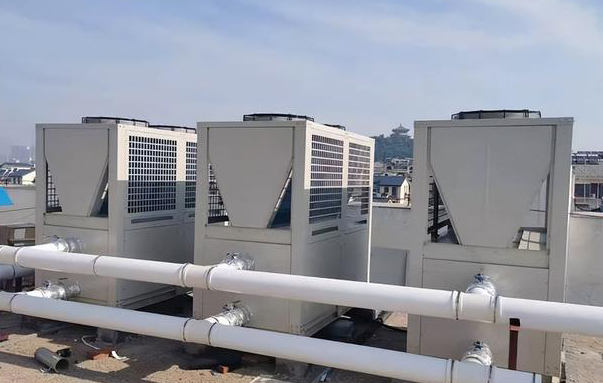1. Differences in heat transfer mechanisms
The air conditioner mainly adopts the fluorine circulation system to realize the heat transmission. Through rapid heat exchange, the air conditioner can discharge a large amount of hot air from the air outlet, and the purpose of temperature rise can also be achieved quickly. However, such an intense active thermal convection scheme will reduce the indoor humidity, make the air-conditioned room extremely dry, and increase the evaporation of human skin moisture, resulting in dry air, dry mouth and dry tongue.
Although the air source heat pump also uses the fluorine cycle for heat transfer, it no longer uses the fluorine cycle for heat exchange indoors, but uses the water cycle for heat exchange. The inertia of water is strong, and the heat storage time will be longer. Therefore, even when the heat pump unit reaches the temperature and is shut down, a large amount of heat will still be emitted from the hot water in the indoor pipeline. Even though fan coil units are used for heating, like air conditioners, the air source heat pump can continue to deliver heat to the room without increasing the electrical load.
2. Differences in operation mode
The air source heat pump needs to heat the room. Although it is powered on all day, the unit will stop working when the heating is completed, and the system will enter the automatic thermal insulation state. When the indoor temperature changes, it will restart. The air source heat pump can work at full load for no more than 10 hours every day, so it will save more power than air conditioning heating, and can protect the compressor well, extending the service life of the equipment.
Air conditioners are used frequently in summer, especially in northern areas. In winter, there are floor heaters and radiators for heating, and air conditioners are rarely used. While the air source heat pump integrates hot water, refrigeration and heating, and runs for a long time in winter, especially when heating and hot water are needed for a long time in winter, and the compressor runs for a longer time. At this time, the compressor basically runs in the area with higher refrigerant, and the operating temperature is one of the main reasons affecting the service life of the compressor. It can be seen that the comprehensive load of the compressor in the air source heat pump is higher than that of the air conditioning compressor.
3. Differences in use environment
The domestic central air conditioner shall comply with the national standard GBT 7725-2004. The nominal heating condition is the outdoor dry/wet bulb temperature of 7 ℃/6 ℃, the low-temperature heating condition is the outdoor 2 ℃/1 ℃, and the ultra-low temperature heating condition is – 7 ℃/- 8 ℃.
Low temperature air source heat pump refers to GB/T25127.1-2010. The nominal heating condition is outdoor dry/wet bulb temperature – 12 ℃/- 14 ℃, and the ultra-low temperature heating condition is outdoor dry bulb temperature – 20 ℃.
4. Difference of defrosting mechanism
Generally speaking, the greater the difference between the temperature of the refrigerant and the outdoor ambient temperature, the more serious the frost will be. Air conditioning uses large temperature difference for heat transfer, while air source heat pump relies on small temperature difference for heat transfer. The air conditioner focuses on refrigeration. When the maximum temperature in summer reaches 45 ℃, the exhaust temperature of the compressor reaches 80-90 ℃, or even exceeds 100 ℃. At this time, the temperature difference is more than 40 ℃; The air source heat pump focuses on heating and absorbs heat in a low temperature environment. Even if the ambient temperature in winter is about – 10 ℃, the temperature of the refrigerant is about – 20 ℃, and the temperature difference is only about 10 ℃. In addition, the air source heat pump also has a pre defrosting technology. During the operation of the heat pump host, the middle and lower parts of the heat pump host are always in a medium temperature state, thus reducing the frost phenomenon of the heat pump host.
Post time: Oct-04-2022


